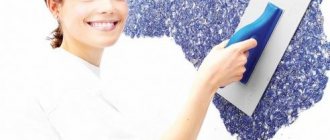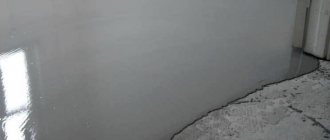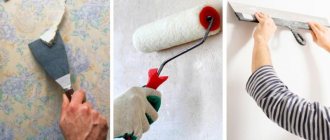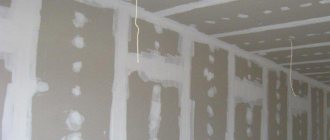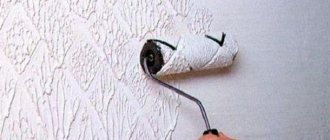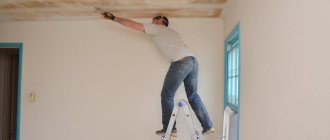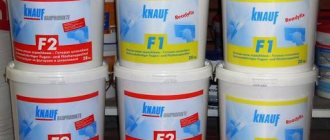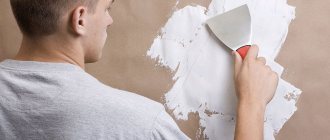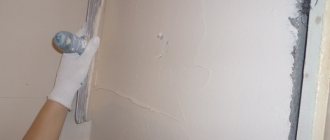When the walls are covered with plasterboard, many people start thinking about finishing. Such issues need to be resolved in advance, although this is not critical. The resulting smooth surface can later be prepared for painting, wallpapering, applying liquid wallpaper, laying tiles and applying decorative plaster, etc. We will look at how to putty drywall under wallpaper. This process is so simple and accessible that even a beginner can handle it.
The most difficult thing is to prepare gypsum board for decorative plaster and painting, but for further wallpapering it can be easily puttied with your own hands.
Do I need to putty drywall?
Nobody wants to do extra work. In addition, putty is a long, difficult process that takes a lot of time. A reasonable question arises: why putty on the flat surface of plasterboard sheets. Maybe you can do without it during finishing? With some types of finishing it is possible, but not with all.
You should always seal sheet joints, corners and screw heads. For any type of finish. Be sure to putty the gypsum board before painting. The surface of the drywall is far from ideal, and new irregularities are added during transportation and installation. If you paint the surface without first leveling, they will all be clearly visible, especially if there is at least a slight degree of gloss.
Preparing drywall for wallpapering - you can only putty the seams, then prime the surface
The Knauf company, one of the leaders in the production of drywall, allows the entire surface of the sheets not to be puttied under tiles and wallpaper. Only joints, corners and screws. No one uses putty for laying tiles, but yes, for wallpaper. And all because wallpaper pasted without pre-treatment sometimes comes off along with the cardboard and sometimes even down to the plaster. So the second time, putty is simply inevitable.
You can avoid puttingty the entire surface of the sheet by using a primer. In this case, the primer is water-dispersed acrylic paint diluted with water. It creates a film on the surface with which the glue interacts well, but this film also prevents the cardboard from being damaged when the wallpaper is torn off.
Before painting, it is necessary to putty the drywall completely, and until it is in perfect condition.
So, it is absolutely necessary to putty the drywall before painting, preferably before wallpapering (at least in one layer) and only seal the screws and seams under the tiles.
Preparing the tools
Our fatigue and the speed with which finishing work is performed depends on the correct choice of tools.
To apply gypsum board putty under the wallpaper, you will need the following kit:
- spatulas with different blade sizes;
- roller;
- a knife with a sharp blade for chamfering;
- electric drill with mixing attachment;
- rule;
- container of a suitable size for preparing the batch.
Experts advise using stainless steel spatulas to prevent rust from appearing on the walls.
Primer for drywall: why, what and when
The primer performs two different functions. The first is that it improves the adhesion (adhesion) of two materials. As a result, when puttying, the chances of bubbles forming and material peeling are reduced. The second function is that it evens out absorbency. The result is less material consumption, and when puttying, a more even surface. So it is not advisable to skip the primer.
In theory, priming during finishing work should be done before each new operation. For example, before puttying, plasterboard sheets need to be primed to improve adhesion to the putty. Before painting or wallpapering - to reduce the consumption of paint and glue. You also need a primer before applying the finishing layer - the starting layer has to be leveled, which is why the surface turns out dusty. Without primer treatment, the finishing layer does not apply well, rolls off and may even fall off.
Primer for drywall from Ceresit is also suitable for interior work.
What primers are needed? Depends on the stage and the type of finishing material:
- Before puttying gypsum board (starting and finishing layers), use a deep penetration primer or for porous, highly absorbent surfaces.
- The same composition can be used before painting and wallpapering.
- The putty surface of the plasterboard under the wallpaper can be primed with wallpaper glue diluted with water. The proportions are indicated on the glue packaging.
- When painting, you need to look at the manufacturers' recommendations. Sometimes the primer is paint diluted with water. If there are no other instructions, use a deep penetration composition.
To summarize, it is worth saying that priming is a necessary operation. It allows you to get good results and reduce material consumption.
Important finishing nuances
When it comes to interior wall decoration, plasterboard occupies a leading position due to its ease of installation and excellent heat-insulating properties. Thanks to the smooth surface of the sheets, a perfectly flat wall is achieved, which can later be easily painted or wallpapered.
Before decorating the walls with wallpaper, it is recommended to pre-putty the plasterboard. If this is not done, the joints of the sheets will show through the wallpaper, giving the wall a sloppy look.
Also, when pasting wallpaper directly onto drywall, it will subsequently become difficult to remove it - it will be removed along with the top layer of finishing material.
Important! In order not to make a mistake when choosing a putty, you should know that it is classified according to its composition and binding components.
Technology: sequence of work
After the gypsum board sheets are fixed to the frame, it is time to prepare the drywall for finishing. Let's consider the case with a full cycle - for painting. In this case, the drywall must be puttied in at least two layers. For other types of finishing that are less demanding on surface quality, we simply remove unnecessary steps. The order of work is as follows:
- Coating with deep penetration primer.
- Sealing screw holes.
- Puttying joints using serpyanka mesh or special paper tape.
- Sealing corners - external and internal.
- Primer for drywall.
- Puttying the entire surface with the starting composition and sanding any uneven surfaces.
- Primer for gypsum board.
- Putty with finishing composition and putty of uneven surfaces.
- Primer coating for finishing.
Do-it-yourself drywall putty - learning the nuances
A few words about which putty is best to use for gypsum board. Any one will do - gypsum or polymer based (latex). Polymer putties are usually finishing - they provide a very thin layer and a smooth surface. There are both starting and finishing plaster ones. Difference in particle size. You can use any, as long as the quality is good.
There are two forms of drywall putty - dry in bags and diluted in buckets. Before use, dry mixture must be diluted with water in the indicated proportions and stirred until lumps dissolve. Compositions in buckets are already ready for use, but are more expensive. But they are guaranteed to have no lumps.
What kind of putty is needed for gypsum boards
Plasterboard sheets are puttied with 3 types of solutions. The leveling composition can be made based on cement, gypsum or a mixture of polymers.
Types of leveling materials
According to its purpose, putty is divided into starting, finishing and universal compositions:
- The starting product is intended to putty drywall joints, dents from screw heads, and vertical and horizontal corners of the room. The starting putty is applied once.
- Finishing wall putty is used to finalize the surface of fences for wallpapering. Depending on the quality of the finishing material and the professionalism of the worker, the finishing putty is applied in one layer. The final putty of drywall is done over the entire surface of the walls.
- The universal mixture is used for both initial puttying and finishing puttying of gypsum plasterboard walls. Universal putties are mixtures of polymer materials.
The starting composition differs from the finishing solution by the presence in its structure of a larger solid filler (crushed quartz sand).
Places that are plastered with starting composition
Form of delivery to the putty retail chain
Manufacturers of building materials produce putty in dry and finished forms. Dry mixtures are sold in paper bags weighing from 5 to 25 kg. The finished putty is packaged in plastic containers weighing from 5 to 30 kg. Sometimes there are packages weighing more than 30 kg.
Calculation of putty consumption
Volma gypsum putty for sealing joints
Before puttingtying drywall, you need to determine the approximate volume of putty that will be needed for the work.
There is a simple method for determining the need for this material. The calculation is made based on the consumption rate of 1 kg of ready-made solution per 1 m2 of gypsum board. Add another 100 grams of the mixture for unexpected losses. The total need for putty on average for 1 layer will be 1.1 kg per 1 m2 of surface.
You need to know that the manufacturer indicates the consumption rate of putty on the product packaging.
Cost table for some types of putty
| № | Name of putty | Delivery form | Weight, kg | Price, rub |
| 1 | Volma, starting | Dry mix | 25 | 446 |
| 2 | Prospectors, universal | Dry mix | 20 | 330 |
| 3 | Versilk, gypsum finishing | Dry mix | 25 | 370 |
| 4 | Shitrock, finishing | Ready solution | 28 | 1 350 |
| 5 | Rotband, finishing | Ready solution | 18 | 793 |
Primer coating
Before you putty the drywall, prime the surface. Any primer is applied to a dry, clean base. Therefore, we first remove dirt from the surface and remove dust (you can use a vacuum cleaner or a slightly damp cloth). After this, prepare the soil according to the instructions (sometimes you need to dilute it with water, sometimes you just need to stir it), pour it into a container and apply it with a brush or roller.
Applying a primer: choose a method convenient for you
Drywall primer is available for dry and wet areas. For the bathroom and kitchen, choose soil for wet rooms; for the rest, you can use any soil. When choosing soil, pay attention to the presence of antibacterial components. They prevent the development of mold and fungi. This is especially true for the kitchen and bathroom.
| Name | Consumption | Purpose | Drying time | Additional properties | Price |
| Penetrating primer Optimum (10 l) | 6-8 sq.m/l | For priming brick, concrete, plasterboard in dry rooms. | 30-40 min | 600 rub for 10 kg | |
| GLIMS Grunt (10 l) | 5 sq.m/l | For rooms with normal and high humidity | 30 minutes | Anti-fungal and anti-mold additives | 600 rubles for 10 l |
| Tex Universal acrylate primer | 5-14 sq.m/l | For priming porous surfaces, including plasterboard and putty surfaces | 30-40 min | For dry rooms and rooms with high humidity | 650 rubles for 10 l |
| Internal primer Prospector 10l | 5-10 sq.m/l | For priming porous surfaces, including plasterboard and putty surfaces | 60 min | Anti-fungal and anti-mold additives | 350-400 rubles per 10 l |
| Feidal Tiefgrund LF 10 l | 10 sq.m./l | For highly absorbent surfaces, including drywall | quick-drying | For indoor and outdoor use, frost-resistant | 850 rub for 10 l |
Usually, for priming drywall, it is enough to apply the composition in one layer, but in the kitchen or bathroom you can use two: to guarantee the result. After the soil has dried (the time indicated in the instructions), you can proceed to the next stage.
Putty for drywall – what to choose?
How to putty drywall largely depends on the composition and purpose of the putty. On sale you can find mixtures made on a cement, gypsum or polymer base. Cement and gypsum are produced in bags in the form of finely ground powder. When preparing, they are diluted with water in the required proportions. Polymer putties are ready-to-use pastes, packaged in buckets.
The advantages of cement putties are strength and resistance to water. Most often they are used in damp rooms to work with moisture-resistant drywall. Gypsum putties are flexible, economical in consumption and easy to sand. Their area of application is only dry rooms.
Compositions based on polymer binders - acrylic or latex - are universal. They are not afraid of water, apply well, and can be sanded without any problems. Putties differ in the size of the filler grains. Mixtures intended for leveling out gross errors are called starting mixtures, and for final fine processing - finishing. The thickness of the applied layers varies from 0.2 to 5 mm.
Modern high-quality putties for drywall are environmentally friendly, resistant to shrinkage and cracking, and durable. Leading manufacturers are Knauf, Weber-Vetonit, Sheetrock, Ceresit and others.
Sealing screws and seams
For seams there are special compounds Knauf-Fugen, Knauf Uniflot, Fugenfuller and their analogues. After the soil has dried, dilute the putty to the consistency of thick sour cream. Please note that these putties dry quickly, so dilute a small amount at a time.
We take a small spatula, apply the composition to the places where the screws are installed, and remove the excess. There should be just enough putty in this place so that the surface is even. This way we go through all the screws. They can be sealed parallel to the seams, or they can be sealed first. It doesn't matter.
The principle of working with putty is that a roller of the compound is placed on the edge of the spatula, then it is stretched in the right place
There are two types of drywall joints. Along the long side of the gypsum board, the edges are uneven - for easier sealing of this joint. But the sheets are also connected in height, where there are no ledges. You also have to cut the sheets and the joint is also end-to-end. Such connections require special technology, which will be discussed below.
Vertical joints
When puttingtying vertical joints of drywall with normal factory edges, they are first carefully filled and then glued.
After filling, while the composition is still wet, it is glued with a sickle mesh or paper reinforcing tape. This is necessary so that cracks do not form at the joints. If tape is used, it is torn into the required pieces and soaked in clean water for 10 minutes (while the seam is being filled).
The tape is recessed to the required distance
Having filled the seam, take out the tape, hold it between your fingers, remove excess water, and glue it to the seam. Then take a spatula 8 cm wide (this is a must) and press the tape below the surface of the gypsum board. She “sits” on one of the factory ledges. They begin to press from the middle to the edges. When pressed, the putty is squeezed out from under the tape; we collect it. As a result, if you apply a wide, hard spatula (at least 20 cm wide) to the surface, you can see that the tape is below the surface of the cardboard. Then they go through putty again, leveling the joint level with the surface.
Trimmed seams
It is better to putty plasterboard in places of horizontal joints - where two slabs are connected or on vertical ones, but without edges, after pre-treatment. First, the surface is moistened with water - dip the brush in water and coat the joint well. Walk several times until the plaster gets wet. Then use a sharp knife to cut grooves at an angle of 45°. These joints can be treated before priming. It's even more convenient.
Preparing seams for putty
We coat the prepared joints with primer. In this case, it is more convenient to use a brush. After drying, fill the seam with a composition for puttying drywall joints. It is more convenient to work with spatulas 10 cm wide and hard 20 cm. Apply the composition with a small one, and remove the excess with a large one. Fill well, pressing the composition into the seam. If you did everything correctly, a small roller will form, slightly protruding above the surface.
Once again we go through the seam, applying fresh putty about 0.5 mm thick, take the soaked reinforcing tape and glue it to this compound. Use a spatula 8 cm wide and press the tape well onto the surface, squeezing out the excess putty from underneath it.
Puttying of cut seams on gypsum boards
In this case, a wave of paper is formed (you can see it in the photo), we make sure that it does not wrinkle, we catch it to the end, where it straightens out. Remove excess solution into the tape and adjacent area of the sheet. And the last stage - again take the putty and coat the pasted tape on top with a thin layer. We make this layer as thin as possible, as they say - “to tear off”. Actually, we stretch the remaining putty in a very thin layer.
Second technology: first tape then putty
There is a second technology - first, serpyanka or paper reinforcing tape is glued onto the plaster, then it is puttied. This works faster, but the disadvantage is the voids that remain under the tape. In these places, the wallpaper may wrinkle or the putty or decorative plaster may crack.
This is how you stick serpyanka onto drywall
They also use sickle mesh instead of paper tape. Serpyanka is more difficult to work with - it is rigid and its edges often stick out from the mortar. To make it a little easier, the mesh is pre-glued, and after the glue has completely dried, it is puttied. In order not to think about glue and speed up the work, use a self-adhesive serpyanka (there is such a thing).
An example of puttying a seam with serpyanka
But, anyway, it’s more difficult to putty drywall - its surface is uneven, the spatula “jumps” on the fibers and you get a small wave that is not at all easy to smooth out.
External and internal corners
External and internal corners on plasterboard walls and partitions are made using:
- reinforcing paper;
- serpyanka;
- perforated aluminum corners;
- special metal corners Shitrok with paper.
There are different perforated corners, but it is more convenient to work with the metal corner Shitrok
Paper and serpyanka are most often used to decorate internal corners - the junction of walls, as well as walls and ceilings. The technology is similar to seam sealing. A certain amount of putty is applied to the corner, paper or sickle is glued onto it, the reinforcing strip is pressed into the composition with a narrow spatula, and excess putty is removed. After this, they go through the corner again, applying a thin layer of putty on top.
Perforated corners are used to design external corners - slopes, protrusions, etc. First, a piece of the required length is cut. The metal is very thin, it can be cut even with ordinary large scissors, but if you have metal scissors, the work is easier. Edges are cut at an angle of 45° or less, rather than at 90°. So, when puttingtying drywall, the edge will not curl up.
Decorating the outer corners of plasterboard walls using a perforated corner
Putty is applied to the outer corner on both sides in small islands approximately every 10 cm (can be done in a checkerboard pattern). A perforated corner is pressed into the solution, its installation is checked whether it is vertical or horizontal, and adjusted. Use a spatula to pick up excess mortar, aligning the edges in one plane with the surface of the sheet. The installed corner is left for some time until the putty dries, after which it is sanded and puttyed again if necessary.
What is different about the metal corner Sheetrock? Thin strips of metal are applied to a paper base. They are more rigid than simple reinforcing paper, but it is more convenient to work with them than with conventional perforated ones, since due to the presence of paper the transition to plane is smoother.
Preparing the surface for gluing after puttying
After the putty has dried, the walls are sanded with special abrasives: mesh or sandpaper.
The advantages of mesh are its wear resistance and the absence of dust accumulation, however, sandpaper is a more common choice due to its affordable price, despite its rapid grinding and frequent clogging. Also, for better sanding you will need a flashlight: a beam of light at an angle of 45° will show all the imperfections of the wall. You can do without sanding if putty is applied professionally, but even experienced craftsmen clean the finished finish with at least zero-grit sandpaper.
Sanding corners requires special attention: for this purpose, use a special sanding sponge with beveled edges.
Sanding seams and corners
If the layer is well leveled when sealing seams on drywall, sanding can be kept to a minimum. Why is it better to sand less? Because firstly, it’s long, and secondly, it’s dusty. Moreover, the dust is very fine, floats in the air for a long time and rises again from any movement. To reduce the amount of flying dust, wet rags, wet sawdust, etc. can be placed on the floor. Doors leading out of the room are covered with a wet cloth; it should be larger than the size of the door - so that dust does not fly into other rooms.
To begin with, you can go over it with a sharp, even spatula and cut off all the most protruding irregularities. Next is the sanding process. Since corners and seams at this stage do not need to be sanded to perfect smoothness, take a sanding mesh with a mesh size of 180-200 and a wooden block. A mesh is attached to the block (you can use staples from a construction stapler, but the staples should not stick out). This device levels the surface. When working, it is advisable to highlight it with oblique light - this way all the irregularities are more visible. But you can’t putty plasterboard under wallpaper so carefully.
There are special holders for the mesh, but you can get by with a block
One thing - it’s better to grind in a respirator and safety glasses. Gloves will be a good idea. The dust is very fine and penetrates literally everywhere. After the seams and corners are sanded, the surface is primed again. Moreover, all of it, since dust has also settled on the untreated areas, and it worsens adhesion.
The most inconvenient places for puttying and sanding are the inner corners. For the secrets of fast, high-quality grinding of corners, watch the following video.
How to putty drywall: level the planes
To putty surfaces, you will need a large spatula - with a blade of 40 cm or more and a narrow one - 10 cm. The first layer is applied with starting putty. It is applied in a layer of about 5 mm (the maximum should be checked in the instructions for the specific putty) and hides all the unevenness. Dilute it with water until it becomes thick sour cream, stir thoroughly so that there are no lumps.
These spatulas are needed to putty drywall over the entire surface.
The technique for puttingtying the surface of drywall is simple: take a large spatula, at its end using a small spatula, lay out a roller of putty. We press the blade to the surface and stretch the composition. We repeat several times, filling some part of the wall or ceiling. Then we clean the blade and run it over the newly puttied surface, leveling it. You need to level it as carefully as possible - less time will be required for grinding.
When you have finished puttingtying the drywall, wait until it dries. Then you take a familiar tool - a block with a mesh - and smooth out all the flaws. Sanding is completed, remove the dust, and cover the surface again with a deep penetration primer. After drying, begin applying the second layer.
This is how you hold the spatula
Next, you need to putty the drywall with a finishing compound. As they wrote, it can also be gypsum-based, like the starter one, or it can be polymer-based. Both are suitable, but some are more difficult to work with - they quickly begin to roll and harden.
The finishing putty is made more liquid and applied in a thinner layer. The application technique is the same, nothing changes. Besides the fact that it is more difficult to work with, it spreads worse, but you need to stretch it in a thin layer and quickly level it. Everything is much better with a primer, but without it, the bottom layer quickly draws moisture out of the fresh plaster and it begins to roll off. After applying the finishing putty, wait until everything dries again, then begin leveling. But this time they do not use a mesh - it leaves noticeable grooves, but fine-grained sandpaper. It is not so convenient to work with - it clogs quickly, but the surface is smooth. If you are preparing the surface for painting, we light it from below or from the side and you can use an LED lamp rather than an incandescent lamp - all flaws are visible. Even very small ones.
It is difficult to describe in words how to putty drywall - the movements are difficult to describe. In the video you can see how to hold the spatula, how to move it, how to apply or remove the solution. See the video for more details on the technology.
And further.
Seven steps for finishing gypsum plasterboard under wallpaper
We’ve sorted out the reasons, tools and materials, now it’s time to talk about how to properly putty drywall for wallpapering.
Step No. 1: correcting the builders’ shortcomings
It doesn’t matter whether you installed the gypsum plasterboard frame yourself or hired people; in any case, you need to carefully check the build quality again and correct minor defects.
Fastening the gypsum board sheet.
One of the sore points of any frame is the quality of screwing in the screws, or more precisely, the depth to which they were driven. The ideal option is when the screw head is slightly recessed into the cardboard.
- First, take a wide metal putty knife and run the blade along all the walls. If the head of the screw is visible somewhere, the spatula will “stumble” on it and you will need to slightly tighten the screw;
If you rarely “communicate” with a screwdriver, then it is better to take a simple screwdriver and tighten the protruding screw heads manually. A good, powerful screwdriver can drive a self-tapping screw too deep in the wrong hands.
Screwing screws into gypsum boards.
- It’s worse when the self-tapping screw is driven more than halfway; in this case, only additional fixation of the sheet with another self-tapping screw can save the situation. Keep in mind that it cannot be screwed next to or into the same hole, the minimum distance is 50 mm;
- If you miss a deeply recessed screw, then over time it may break out and cracks will appear along the sheet, and this will lead to creases or even breaks in the wallpaper;
- Another common defect is fringe along the cut edge of the plasterboard, but this defect can be called an innocent prank. Here you take a knife and cut off all excess, after which you lightly sand the edge.
The result of skewed drywall.
If you find traces of fungus on the sheets, try to remove them with sandpaper. But the main thing is to choose a soil with complex action and good protection against biological pests.
Step #2:. Trimming the joints
The factory edge of the gypsum board sheet has a rounded shape, and if there are 2 such edges at the junction, then there is no need to touch them, but this situation does not always happen.
When two evenly cut edges of a sheet meet, the putty in this place will not adhere well, even if it is reinforced. Therefore, such drywall joints must first be trimmed.
Cut joint.
The procedure here is quite simple: take a construction knife and cut both edges inward at an angle of approximately 45º. This groove is made approximately half or even 2/3 deep of the sheet.
Step No. 3: priming the walls
We have already talked about choosing a primer, but applying the composition itself usually does not cause any difficulties for anyone. Pour the composition into a container, take a wide brush or roller and cover the structure with primer, carefully treating all problem areas.
Primer of gypsum board walls.
Often one coat of primer is sufficient. If the sheet has been affected by a fungus, then it will need to be covered with soil twice. Double coating with soil is provided even with continuous reinforcement of gypsum boards, but in what case it is necessary, I will tell you a little later.
Step No. 4: reinforcement and puttying of corners
Puttying corners can be called the most important work in the entire process. As you know, there are external and internal corners and they are finished differently.
The outer or outer corner of the gypsum board frame must be reinforced. For these purposes, special perforated corners are now produced; the corners can be aluminum, galvanized steel or plastic.
Types of corners.
Galvanized steel corners will cost you the cheapest, but I don’t recommend using them. The fact is that if the protective layer of zinc coating is damaged somewhere, the steel will begin to rust and a yellow spot will sooner or later appear on the wallpaper.
The home handyman should reinforce even corners with aluminum corners. If the dimensions of a gypsum plasterboard structure allow, then it is better to buy corners with additional reinforcement; wide strips of reinforcing mesh are attached to them on both sides; such surfaces are easier to level.
Corner with additional reinforcement.
- First, a small amount of putty is evenly applied to both planes of the angle. After this, until the mixture begins to set, you need to sink the aluminum corner into it;
- You should press tightly, but without fanaticism, so that the corner does not bend. I press such corners using a plaster rule, applying the tool along the entire length of the corner, but in principle, any strong and even plank is suitable for these purposes. By the way, if a corner is bent, it is almost impossible to straighten it unnoticeably;
- Naturally, the composition you applied to the walls will be squeezed out through the holes; all this excess is immediately leveled with a small spatula. Now let the composition dry, you need the corner to firmly grip the base;
Arrangement of the doorway.
- The next step is step-by-step finishing. First, scrape off any dried excess mortar and go over it again with primer. When the primer is completely dry, you can begin finishing the corner;
- To do this, I use a medium spatula with a blade of about 20 cm. The mixture is evenly applied in small portions to the blade along the entire length. We cover the corner slowly, moving from top to bottom. The reinforcing structure must be completely covered with putty;
- There is no need to “grab” both planes at once; first, draw out the corner on one side, and when this side is dry, start the same work only on the adjacent plane of the corner. It is unlikely that everything will turn out perfect the first time, but mastery comes with experience.
Aluminum corner fastening.
Plastic corners are intended primarily for reinforcing rounded complex structures. There are no special differences in the arrangement technology here, but to be honest, the rounded corners and curves of the frame are more difficult to finish.
To reinforce the internal corners, fiberglass mesh tape is used; in professional jargon it is called serpyanka. Some serpyanka models are equipped with an adhesive surface, making them much easier to attach.
Although, if there is no serpyanka with an adhesive side on the market, just take PVA glue and glue it into the corner in the traditional way.
Putty on glued serpyanka.
Remember, the inner corner is reinforced with two separate strips, which are joined together in the corner without overlapping. I have met innovators who bent a wide serpyanka lengthwise and glued it into a corner with a single tape, and after six months the wallpaper in this corner began to look like an accordion.
The inner corner is puttied in approximately the same way as the outer one, that is, first you finish one side completely, and after it dries, you begin the same procedure on the other side.
Working with an angle spatula.
Now special corner spatulas are sold for finishing internal corners on two planes at once. I don’t recommend those who like to take up such spatulas; it’s better to learn using classical technology, finishing the planes one by one. The classic technology is also good because after mastering it, it will not matter to you what degree of rotation you use to finish the corner, but the corner spatula is curved strictly at a right angle.
Flexible plastic corner.
Step No. 5: sealing joints along the plane
You remember that in step No. 2, even before treating the sheets with primer, we trimmed and deepened all the joints. Now, before we putty the drywall under the wallpaper, we need to reinforce and seal these grooves.
Sealing the joint with the factory edges.
For this procedure we will use the same aforementioned fiberglass sickle. Many craftsmen glue the tape directly to the joint, after which they apply a putty mixture. But I was taught by the old masters, and I do things a little differently:
- First, with a small spatula, I apply a layer of finishing putty to the empty primed groove, while the groove is completely filled, plus the composition extends on both sides of the joint no less than the width of the tape;
- Immediately, before the composition has set in, we need to drown our serpyanka. Simply apply the tape to the fresh putty and run the putty knife over it. After which you leave our joint alone and let the solution harden completely;
Roll of serpyanka.
In order not to waste time while your joints between the sheets are drying, you can putty the heads of the screws. No special professionalism is required here; take a narrow spatula and cover all the holes with cross-shaped movements.
Glue the serpyanka onto the fresh compound.
- The finishing putty has one unpleasant feature: it shrinks slightly. Therefore, when the composition at the junction hardens, where our groove runs, it will sit down a little and the groove will be visible, but this should not be allowed;
- There is no particular point in priming the same putty a second time; just lightly sprinkle the surface with water and you can apply the finishing layer, which will hide both the sickle itself and the recess at the junction of the sheets;
- At the last stage of sealing the joints, when they are completely dry, you will need to lightly level and sand the surface with coarse sandpaper or sanding mesh.
Sealing joints over serpyanka.
In the store, serpyanka refers to both fiberglass mesh, construction bandage and perforated paper tape. So, what you need is fiberglass mesh, the construction bandage will bubble and curl, and only a “savvy” professional can install the perforated paper tape.
Step No. 6: finishing along the plane
It is more convenient to finish the surface with a wide spatula with a blade of 30 cm or more. The quality of the blade on this spatula directly determines how smooth and beautiful your wall will be. Therefore, my advice to you is to keep one spatula for intermediate work and another for finishing.
Applying the first layer to the walls.
To put it mildly, working from a stepladder under the ceiling is not very convenient; there are too many unnecessary movements. If there is no “goat”, then I try to adapt some reliable table for these purposes, most often it is a kitchen table.
The technology itself is not complicated, but you need to work quickly, since the hardening time of the solution is not that long. Here it is advisable to have an assistant who will mix the next portions of putty while you are working on the wall.
- The steps are something like this. Apply the composition in small portions onto the blade of a wide spatula, and then rub it into the wall with wave-like sweeping movements;
- While you don’t have enough experience yet, it’s better to start from the farthest and least noticeable corner possible. So, when it comes to the central part of the wall, you will already have gained some experience and skill;
Work with a wide professional spatula.
You don’t need to put a lot of solution on a wide spatula, just take small portions. The thing is that if you try to apply a lot of putty at once, you will end up with bumps, and then you will have to smooth them out.
- The composition should be applied in 2 layers, but there is no need to wait until the first layer dries. I usually finish a few square meters or a whole small wall. And when I reach the end of the sector, I simply return and start the same work over again;
- Well, that's not all, the next day, when the walls are guaranteed to be dry, take a block in your hands, attach a coarse sandpaper or sanding mesh to it and start sanding the surfaces.
Grinding the plane with a block with a stretched mesh.
Ideal quality wallpaper is not required, in fact, that’s why you use coarse sandpaper; it’s enough to smooth out all visible defects and wipe off the dust with a damp rag.
Step No. 7: subtleties of putty under wallpaper in a new house
If the house is old, then what I told you above is enough. But when it comes to a new building, the technology continues, because any new house will shrink for several years and the plasterboard frame will inevitably begin to weaken, which means that the wallpaper may also develop creases and distortions.
To avoid this, it will be necessary to completely reinforce the entire surface of the sheets. In other words, you do everything that I have already told you, and after that you create additional reinforcement.
Fiberglass canvas.
For continuous reinforcement of gypsum boards under the wallpaper, a cobweb is used, which is popularly called a thin fiberglass canvas. The surface you have prepared will need to be primed again and, after drying, covered with cobwebs; the cheapest option is to use PVA glue, although now there are special compounds.
The canvases are glued with an overlap of a couple of centimeters, and while the glue is not hardened, this overlap is cut in the center with a sharp knife. Ultimately, when you remove the excess trimmings, your covering will be butt-joined.
After such trimming, you will need to once again cover the entire wall with PVA glue and leave it to dry for a day. At the last stage, the wall reinforced in this way is covered with a finishing layer of putty and, after drying, sanded again.
Reinforcement of gypsum boards with cobwebs.
